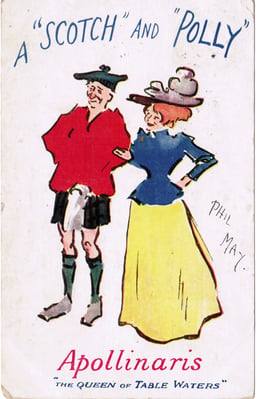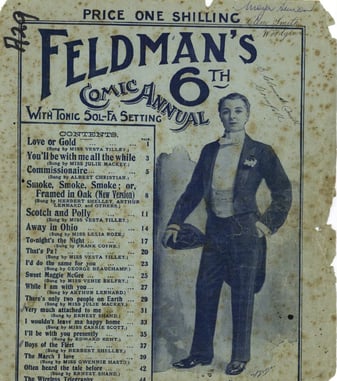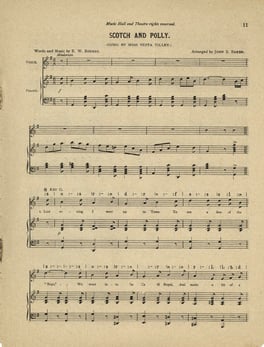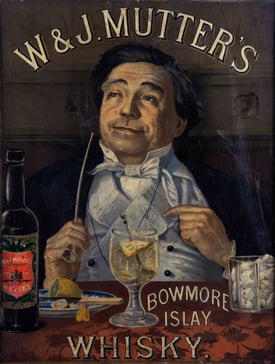The rise of the Scotch and soda
- Tracy Wason
- December 4 2023
 The rapid growth of blended Scotch in the last quarter of the 19th century turned the world of whisky upside down. “Blended whisky,” wrote Ridley’s Wine and Spirit Trade Circular in 1915, “attracts the consumer largely, and Englishmen in particular have been gradually trained to the lighter styles of blend which they can drink with soda water – quite different to the taste of a quarter of a century ago.” Sales of Scotch blends had grown rapidly since the 1880s as a result of the catastrophic decline in the quality (but not availability) of brandy, following the arrival of Phylloxera in France. The Lancet wrote: “In Pickwickian times, the favourite stimulant was brandy-and-water, later it was whisky and water, and now plain water is very generally replaced by aerated water. The popularisation of aerated waters has undoubtedly had much to do with encouraging the drinking of whisky.”
The rapid growth of blended Scotch in the last quarter of the 19th century turned the world of whisky upside down. “Blended whisky,” wrote Ridley’s Wine and Spirit Trade Circular in 1915, “attracts the consumer largely, and Englishmen in particular have been gradually trained to the lighter styles of blend which they can drink with soda water – quite different to the taste of a quarter of a century ago.” Sales of Scotch blends had grown rapidly since the 1880s as a result of the catastrophic decline in the quality (but not availability) of brandy, following the arrival of Phylloxera in France. The Lancet wrote: “In Pickwickian times, the favourite stimulant was brandy-and-water, later it was whisky and water, and now plain water is very generally replaced by aerated water. The popularisation of aerated waters has undoubtedly had much to do with encouraging the drinking of whisky.”
The medical profession, always a guiding hand in the public’s decision making, turned away from brandy as a favoured beverage in the 1880s, as it had done with sherry a decade earlier. “The popular favour with which Scotch Whisky is universally regarded has been largely contributed to by the persistent advocacy of the medical profession”, said the Pall Mall Gazette in 1906. When newspapers reported in 1889 that Queen Victoria’s physician, Sir William Jenner, had recommended that the Queen drink whisky diluted with Apollinaris water, an aerated mineral water imported from Germany, the popularity of whisky and soda, and in particular ‘Polly and Scotch’ was assured.
It wasn’t just royal recommendation, medical endorsement and soda water that accounted for Scotch’s rapidly increasing popularity. Blenders and distillers increasingly sought to produce styles of whisky that suited the palettes of their new consumers both at home, and abroad. “It is to be noted,” wrote Ridley’s, “that Scotch Whisky concurrently with its increasing popularity, has to a large extent been parting with its distinctive peculiarity, the peat flavour.” The heavy, fat and oily whiskies of the 1860s and 1870s were destined for punches or toddies, “hot, strong and sweet”.
“The consumption of this national compound is a grand ceremonial, a solemn sacrifice to Bacchus, conducted with great state and circumstance,” wrote Charles Dickens in 1865. “The dinner is nothing, the toddy afterwards is everything.” This was “rich oily whisky, with enormous peaty flavour”, according to one reminiscence, mixed with boiling water, crushed sugar and lemon, ‘supplied by Mutter, Ramsay and others from Islay.’ The face of W & J Mutter’s Bowmore Islay whisky was that of a bucolic old gentleman in a Georgian top-coat mixing himself a toddy. When James Buchanan first launched his blended whiskies on the market he told consumers exactly how it should be drunk on the label – ‘suitable for Grog and Toddy.’
A question of taste
 “The demand for milder whisky,” said distiller and blender James Greenlees in 1891, “has been increasing enormously.” Old fashioned whisky was a thing of the past. “The whisky that would have been used principally for toddy would have the predominating flavour of Islay, where you would have a strong peaty flavour, and you would get the aroma with hot water. But taken cold, or with aerated waters, you want more of a Glenlivet.” The blender’s need to produce lighter whiskies in turn forced distillers to amend their distillation regimes to satisfy this demand from the new consumers who were driving Scotch Whisky’s massive growth and its changing character.
“The demand for milder whisky,” said distiller and blender James Greenlees in 1891, “has been increasing enormously.” Old fashioned whisky was a thing of the past. “The whisky that would have been used principally for toddy would have the predominating flavour of Islay, where you would have a strong peaty flavour, and you would get the aroma with hot water. But taken cold, or with aerated waters, you want more of a Glenlivet.” The blender’s need to produce lighter whiskies in turn forced distillers to amend their distillation regimes to satisfy this demand from the new consumers who were driving Scotch Whisky’s massive growth and its changing character.
“The public taste in Scotch Whisky has been running against pronounced or peculiar flavours,” wrote Ridley’s in 1893, seeming “to crave more and more for simplicity of style.” The blender’s response made Scotch the first choice for consumers. “Men who formerly drank wine at lunch,” wrote The Wine and Spirit Trade Review in 1905, “take whisky and Apollinaris or soda instead. Malt whiskies, either single or blended malts, are unsuitable here also, for as a rule these do not go well with minerals, and are besides usually too heavy for the purpose.”
“Ladies formerly took a little light wine, claret, or a glass of champagne; now they partake as freely of whisky and sodas as do men,” wrote the same journal. Ridley’s observed: “When, at the Carlton Hotel, and the leading smart feeding grounds of society, one sees even the ladies preferring the whisky and soda, one is struck all of a heap by the ubiquity of the Scotch article.” In the United States, according to a report in 1903, it was “three men out of four” drank “Scotch Whisky and Apollinaris”.
Brands such as Apollinaris, with numerous medical testimonials, had long stressed the purity and health benefits of their mineral waters, and their suitability as an accompaniment for both wines and spirits. The Apollinaris Company, which acquired the rights to the brand in 1873, advertised the virtues of its water heavily. ‘Polly and Scotch’ was already a phrase in common use in England by the late 1870s. Global sales increased from 1.7 million bottles in 1874 to 10.3 million in 1885, and 19.5 million in 1895. In 1897, when the company merged with smaller rival Johannis, the new business was floated with a capital of £3.2 million. Whisky blenders Pattisons Limited had been floated the previous year with a capital of only £400,000, its shares wildly over-subscribed. If there was a craze for Scotch Whisky then there was also one for mineral waters, which (like Scotch) had captured the attention of both consumers, investors, and swindlers. Later, in 1897, financier and fraudster Ernest Hooley acquired and floated Schweppe’s Ltd with a capital of £1.2 million. The rivalry between the two companies provoked one newspaper to speculate “whether the victory will lie with believers in whisky and Apollinaris or apostles of brandy and Schweppe’s.” As it turned out investors in both over-capitalised enterprises were disappointed as dividends never matched the hoped-for levels.
Royal appointment
The big mineral water brands fought for the attention of the public in the battlefields of posters and press, spending lavishly in the process. Royal warrants were exploited shamelessly. Apollinaris was ‘Queen of the table waters’; rival Rosbach was ‘Empress of the table waters’, ‘crowned with universal approval’. The Rosbach Company, whose water came from springs near Frankfurt, had been founded in London in 1878. In the early 1890s they had run joint promotions with John Walker & Sons, sending out small bottles of ‘Kilmarnock Highland whisky’ (‘in combination with Rosbach, a healthful and delicious beverage’) to consumers with cases of their bottled water. In 1901 the brand was purchased by Tommy Dewar, following which Dewars’ Scotch and Rosbach became frequent companions in exclusive supply deals at major exhibitions and entertainments.
Apollinaris focused on artfully exploiting the familiar bar call, ‘Polly and Scotch’, and the increasing popularity of whisky and soda with women. Their advertising agents also pounced on new colour printing technologies to produce posters, showcards and postcards drawn by leading artists and cartoonists such as Hal Ludlow and Phil May. Ludlow’s drawing was used on the cover of the sheet music for the Polly and Scotch barn-dance, composed by Fred Bailey in 1898. ‘Polly and Scotch’ and ‘A whisky and a small Polly” became almost ubiquitous and were embedded in popular culture when in 1900 singer and male impersonator Vesta Tilley adopted a song written by E.W. Rodgers, Scotch and Polly, and performed it in music halls throughout the kingdom ‘to a tumultuous greeting’. The song described the fate of a young man about town who after too many ‘Scotch and Pollys’ met a Scots woman called Polly, who proceeded to relieve him of his belongings:
I lost my way, my rings, my chain, my watch
I either had too much of the ‘Polly’
Or else too much of the Scotch.

The song was a huge hit with audiences and was licensed to the majority of pantomimes performed at Christmas 1900. In 1901, comedian Joe Elvin and his troupe were performing a romantic sketch called Scotch and Polly. Aberdonian comedian Jack Lorimer, famed on both sides of the Atlantic in the early 1900s, sang a song called Scotch Polly (written by American composer Maurice Shapiro), and at the same time a singing and comedy duo ‘Scotch and Polly, twa wee draps o’ real stuff’ were playing at theatres across the country.
Influencers
 In late Victorian and Edwardian Britain, with no broadcast media, advertising and music halls were crucial in shaping popular culture and public taste. Doctors, and that most regal of influencers, may have been responsible for the widespread adoption of Scotch and soda, but its popularity was cemented on the street hoardings, stages and newspaper pages of Britain’s towns and theatres. Brands like Apollinaris, which was selling over 30 million bottles worldwide by the first decade of the 20th century, had done as much (if not more) to promote the ‘whisky & soda’ than distillers and blenders. It would only be in the 1930s that the soda syphon became an almost ever-present in whisky advertising, by which time writers such as Aeneas MacDonald (the first whisky snob) demonised it as the enemy of the whisky aficionado. By then Apollinaris was a shadow of its former self, having fallen heavily out of public favour in the patriotic fervour of the first world war, its place being taken by Perrier, ‘the table water of the allies’.
In late Victorian and Edwardian Britain, with no broadcast media, advertising and music halls were crucial in shaping popular culture and public taste. Doctors, and that most regal of influencers, may have been responsible for the widespread adoption of Scotch and soda, but its popularity was cemented on the street hoardings, stages and newspaper pages of Britain’s towns and theatres. Brands like Apollinaris, which was selling over 30 million bottles worldwide by the first decade of the 20th century, had done as much (if not more) to promote the ‘whisky & soda’ than distillers and blenders. It would only be in the 1930s that the soda syphon became an almost ever-present in whisky advertising, by which time writers such as Aeneas MacDonald (the first whisky snob) demonised it as the enemy of the whisky aficionado. By then Apollinaris was a shadow of its former self, having fallen heavily out of public favour in the patriotic fervour of the first world war, its place being taken by Perrier, ‘the table water of the allies’.
This article first appeared in the winter 2023 issue of The Keeper magazine
Leave your thought here
Your email address will not be published. Required fields are marked *